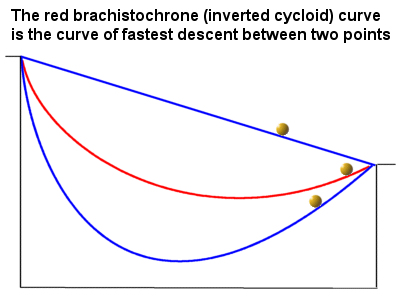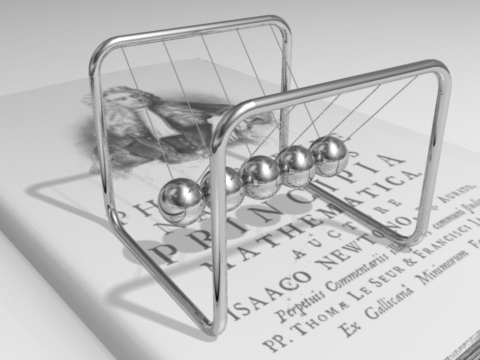In this lesson we'll use the FRW equation to solve for the scaling factor \(a(t)\) in a universe dominated by vacuum energy or dark energy. We'll see that the scaling factor grows exponentially with time; this means that not only is the size of the universe getting bigger and bigger with time, but the rate at which it is doing so is increasing. In other words, the expansion of the universe is accelerating with time.
Finding the Capacitance of a Parallel-Plate Capacitor
In this lesson, we'll prove that the capacitance of a parallel-plate capacitor does not depend on the charge or voltage of the capacitor but, rather, on only the size and geometry of the capacitor.
Brachistochrone problem
The Brachistochrone problem is a very famous problem in the history of physics and is as follows: find the path in which a particle under only the action of gravity will move from one point to another fastest and in the shortest amount of time possible.
Generalized coordinates
In this lesson, we'll give a brief explanation of what generalized coordinates are. Up till this point, we got away with a very vague and imprecise definition. But for some of the problems that we'll look at later (such as the double-pendulum problem), the more technical definition we develop in this lesson will be very useful.
Finding the geodesic on a cylinder
In this section, we'll find the solution (which is a curve x(y)) to the Euler-Lagrange equation where the quantity being minimized is the arc length between any two points on a cylinder. That might sound like a mouthful, but we'll see that hopefully it isn't too bad.
Derivation of Guass's Law from Column's Law
Guass's law: for any charge distribution, whether a system of a finite number of point charges or a continuous distribution of charges, if I draw any arbitrary closed surface (which can be of any shape, size, and location), then the only contributions to the electric flux through that closed surface will be due to only the charges \(q_{enc}\) enclosed within that surface and that electric flux is given by the amount \(\frac{q_{enc}}{\epsilon_0}\). It is important to appreciate the word any to fully grasp the applicability of Guass's law: it applies to any closed surface and to any distribution of charge.
Introduction to Lagrangian Mechanics
Everything in this section will summarize some—a fairly good portion—of what we'll be studying in much more detail in the subsequent sections.
Column's Law
Column's law describes the electric force between any distribution and number of charged particles. It is derived empirically and falls off inversely with the square of the distance, analogous to Newton's law of gravity. The practical usefulness of this law is that it allows one to determine the effect that any distribution of charge has on any other distribution of charge; this is analogous to how Newton's law of gravity allows one to determine the effects of one mass distribution on another. One very gradually learns this by solving many problems. But in this section, we'll start off with Column's law and then proceed to do some algebra and calculus in order to derive equations which describe the electric force that systems and continuous charge distributions exert on an individual particle.
Derivation of the Euler-Lagrange Equation
In this section, we'll derive the Euler-Lagrange equation. The Euler-Lagrange equation is a differential equation whose solution minimizes some quantity which is a functional. There are many applications of this equation (such as the two in the subsequent sections) but perhaps the most fruitful one was generalizing Newton's second law. This equation, together with Hamilton's principle, allows us to generalize Newtonian mechanics and find the motion of systems using generalized coordinates—all of a sudden, double-pendulums don't seem so scary.
Using Guass's Law to find the Electric Field Produced by a Single Point Charge
In this lesson, we'll see that Guass' law makes the same prediction about the electric field produced by a point charge as Column's law.
Electric Flux
Unlike the flux of the velocity field of a fluid, the notion of electric flux is much more abstract. Like concepts such as energy, it is very abstract but nonetheless very useful in analyzing certain situations. In this section, we derive the electric flux of any electric field through any arbitrary surface. Only later one, when we discuss Guass's Law, will we learn about the usefulness of this idea.
Noether’s Theorem
Noether's Theorem is one of the most profound theorems in all of science, let alone physics. It implies that the very fabric of space and time give rise to the laws of nature and lead the mathematician David Hilbert to independently discover the general theory of relativity, alongside Einstein. Noether's theorem, in simplest terms, is the statement that for every symmetry (what a symmetry is is something we'll get to in this lecture) there is an associated conservation law. Our goal in this lecture will be to prove that and show that various different conservation laws follow from an associated symmetry.
What do we mean by "kinematics," "dynamics," and "mechanics?"
The difference between kinematics, dynamics, and mechanics and what each of these terms means is a common point of confusion. But in the most basic sense, the meanings and differences of each of these terms can be described as follows: kinematics describes the motion of an object without consideration of what caused that motion; dynamics describes what caused that motion (namely, a force) without consideration of what the motion of the object is; and mechanics combines the two and describes both the motion and cause of the motion.
Basic Equations of Kinematics
Galileo once pondered how one could describe the motion of cannonballs and other projectiles moving near Earth's surface. Since Aristotle, philosophers had tried for millennia to tackle this problem but it wasn't until Newton invented calculus and formulated the laws of classical mechanics when this question was finally answered. In this lesson, we'll use calculus and Newton's laws to answer this nearly 2,500 year old problem and derive the equations of motion governing projectile motion.
Newton's Law of Gravity
Newton's law of gravity has been described as one of the greatest achievements in human thought of all time. It says that everything in the universe is, quite literally, connected. It must've been an astonishing realization to Newton that a grain of dust in his room exerts a slight "pull" on all of the stars and galaxies in the universe. In the words of Paul Dirac: "Pick a flower on Earth and you move the farthest star."
Introduction to Physics and the Scientific Method
In this section, we delve into some very fundamental ideas which, although expressed with respect to different quantities, are the basis of not only classical mechanics but also relativistic and quantum mechanics as well. These three areas of physics describe the universe within different ranges of parameters: quantum mechanics deals with things on the smallest scale; classical mechanics deals mostly with the size-range of macroscopic objects that we are all familiar with; and general relativity describes the most massive objects in the universe. All of these areas of physics involve some notion of inertia, a state which does not change; each of these areas also have an equation of motion which describes how inertial motion changes. We'll discover that the notions of inertial motion and the change in inertial motion can be expressed in terms of a very small number of elementary rules; and yet, these rules encapsulate a myriad of predictions which encompasses all observable phenomena within a given range of parameters.
Position Vectors, Displacement, Velocity, and Acceleration
Kinematics is the study of the position (represented by the position vector \(\vec{R}(t)\)) of an object as a function of time. The position vector can be used to define other quantities such as velocity \(\vec{v}\) and acceleration \(\vec{a}\); all three of these quantities, together, can fully describe the motion of any object. In this lesson, we'll study these three fundamental quantities of kinematics.
Newton's Three Laws of Motion
In this lesson, we'll discuss the foundation of Classical mechanics: namely, Newton's three laws of motion. Everything else that we discuss in Classical mechanics will be based on these principles.
Derivation of Momentum Conservation
In this lesson, we'll show that the principle of momentum conservation can be derived using Newton's laws of motion.






















